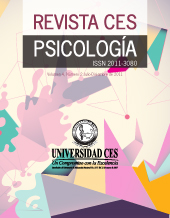Differences in Executive Function between Bilingual and Monolingual Teenagers and Older Adults
DOI:
https://doi.org/10.21615/cesp.5447Keywords:
bilingualism, executive control, teenagers, older adults, neuropsychology, executive functionsAbstract
Our purpose was to compare performance in executive function tasks between bilingual and monolingual adolescents and older adults. A cross-sectional design was used. We evaluated 48 monolinguals (24 adolescents and 24 older adults) and 56 bilinguals (31 adolescents and 25 older adults) with a wide neuropsychological battery that included tasks of cognitive flexibility (Wisconsin card sorting test), inhibitory control (Stroop test), working memory (direct and inverse digits) and access to long-term memory (semantic and phonological fluency). Our results indicate that monolingual adolescents and older adults perform better in executive control tests than their bilingual counterparts, and these differences are minor in bilingual older adults, these differences do not seem to be associated with age and the frequency of use of L1 (Spanish) and L2 (Quechua). These results seem to show that during adolescence there is a cognitive disadvantage in executive function, which is reduced when people get older. The results are discussed considering sociocultural factors and the possibility of understanding bilingualism as a mechanism linked to cognitive reserve.
Downloads
References
Ansaldo, A., Ghazi-Sandi, L., & Adrover-roig, D. (2015). Interference control in elderly bilinguals: appearances can be misleading. Journal of clinical and experimental neuropsychology, 37(5), 455-470. http://dx.doi.org/10.1080/13803395.2014.990359
Arango-Lasprilla, J. C., Rivera, D., Longoni, M., Saracho, C. P., Garza, M. T., Aliaga, A., Perrin, P. B. (2015). Modified Wisconsin Card Sorting Test (M-WCST): Normative data for the Latin American Spanish speaking adult population. NeuroRehabilitation, 37(4), 563–590. https://doi.org/10.3233/NRE-151280
Ardila, A., & Ramos, E. (2008). Normal and abnormal aging in bilinguals. Dementia & neuropsychologia, 2(4), 242-247. https://doi.org/10.1590/S1980-57642009DN20400002
Babor, T. F., Higgins-Biddle, J. C., Saunders, J. B., & Monteiro, M. G. (2001). AUDIT. Cuestionario de Identificación de los Trastornos debidos al Consumo de Alcohol. Pautas para su utilización en atención primaria. OMS, Departamento de Salud Mental y Dependencia de Sustancias.
Bialystok, E., & Feng, X., (2008). Language proficiency and executive control in proactive interference: Evidence from monolingual and bilingual children and adults. Brain and Language, 109(2-3), 93-100. http://dx.doi.org/10.1016/j.bandl.2008.09.001
Bialystok, E. (2001). Bilingualism in development: Language, literacy, and cognition. New York: Cambridge University Press. https://doi.org/10.1017/CBO9780511605963
Bialystok, E. (2009). Bilingualism: The good, the bad, and the indifferent. Bilingualism: Language and cognition, 12(1), 3-11. https://doi.org/10.1017/S1366728908003477
Bialystok, E. (2010). Bilingualism. WIREs cognitive science, 1, 559-572. https://doi.org/10.1002/wcs.43
Bialystok, E. (2011). Reshaping the mind: the benefits of bilingualism. Canadian journal of experimental psychology, 65(4), 229-235. https://doi.org/10.1037/a0025406
Bialystok, E., & Viswanathan, M. (2009). Components of executive control with advantages for bilingual children in two cultures. Cognition, 112, 494-500. https://doi.org/10.1016/j.cognition.2009.06.014
Bialystok, E., Craik, F., & Luk, G. (2012). Bilingualism consequences for mind and brain. Trends in cognitive science, 16(4), 240-250. https://doi.org/10.1016/j.tics.2012.03.001
Bialystok, E., Craik, F. Green, D., & Gollan, T. (2009). Bilingual minds. Psychological science, 10(3), 89-129. https://doi.org/10.1177/1529100610387084
Bialystok, E., Craik, F. I., & Ruocco, A. C. (2006). Dual-modality monitoring in a classification task: the effects of bilingualism and ageing. Quarterly Journal of Experimental Psychology (Colchester), 59(11), 1968-83. https://doi.org/10.1080/17470210500482955
Bialystok, E., Craik, F., & Freedman, M. (2007). Bilingualism as a protection against the onset of symptoms of dementia. Neuropsychologia, 45(1), 459-464. https://doi.org/10.1016/j.neuropsychologia.2006.10.009
Bialystok, E., Craik, F., Klein, R., & Viswanathan, M. (2004). Bilingualism, aging and cognitive control: evidence from the Simon task. Psychology and aging, 19(2), 290-303. http://10.1037/0882-7974.19.2.290
Bialystok, E., Craik, F., & Luk, G. (2008). Cognitive control and lexical access in younger and older bilinguals. Journal of Experimental Psychology: Learning Memory, and Cognition, 34, 859-873. https://doi.org/10.1037/0278-7393.34.4.859
Bialystok, E., Luk, G., Peets, K.F., & Yang, S. (2010). Receptive vocabulary differences in monolingual and bilingual children. Bilingualism: Language and Cognition, 13(4), 525-531. https://doi.org/10.1017/S1366728909990423
Brown, L., Sherbenou, R., & Johnsen, S. (2009). Test de inteligencia no verbal. Apreciación de habilidad cognitiva sin influencia del lenguaje: Manual. Madrid, TEA ediciones.
Calvo, N., Manoiloff, L., Muñoz, E., Contreras, M., Ibañez, A., & García, A. M. (2016). El bilingüismo como protección ante la demencia: inconsistencias empíricas y nuevas propuestas metodológicas. Círculo de lingüística aplicada a la comunicación. 68, 3-44. https://doi.org/10.5209/CLAC.54521
Carlson, M., & Meltzoff, A. (2008). Bilingual experience and executive function in young children. Development science, 11(2), 282-298. https://10.1111/j.1467-7687.2008.00675.x
Colzato, L. S., Bajo, M. T., Van den Wildenberg, W., Paolieri, D., Nieuwenhuis, S., LaHeij, W., & Hommel, B. (2008). How does bilingualism improve executive control? A comparison of active and reactive inhibition mechanisms. Journal of Experimental Psychology: Learning, Memory and Cognition. 34(2), 302-312. https://doi.org/10.1037/0278-7393.34.2.302
Costa, A., & Sebastian-Galles, N. (2014). How does the bilingual experience sculpt the brain? Nature reviews neuroscience, 15(5), 336-345. https://doi.org/10.1038/nrn3709
Costa, A., Hernández, M., & Sebastián-Gallés N. (2008). Bilingualism aids conflict resolution: Evidence from the ant task. Cognition, 106(1), 59-86. https://doi.org/10.1016/j.cognition.2006.12.013
Costa, A., Hernández, M., Costa-Faidella, J., & Sebastián-Gallés, N. (2009). On the bilingual advantage in conflict processing: Now you see it, now you don’t. Cognition, 113(2), 135-149. https://doi.org/10.1016/j.cognition.2009.08.001
Craik, F., Bialystok, E., & Freedamn, M. (2010). Delaying the onset of Alzheimer disease: bilingualism as a form of cognitive reserve. Neurology, 75(19), 1726-1729. https://doi.org/10.1212/WNL.0b013e3181fc2a1c
De la Torre, J., Shimabukuro, R., Varela, L., Kruger, H., Huayanay, L., Cieza, J., & Gálvez, M. (2006). Validación de una versión reducida de la escala de depresión geriátrica en el consultorio externo de geriatría del hospital Nacional Cayetano Heredia. Acta Med Per, 23(6), 144-147. http://www.scielo.org.pe/scielo.php?script=sci_arttext&pid=S1728-59172006000300003
Duñabeitia, J. A., & Carreiras, M. (2015). The bilingual advantage: Acta est fabula?, Cortex, 73, 371-372. http://dx.doi.org/10.1016/j.cortex.2015.06.009
Festman, J., Rodriguez-Fornells, A., & Munte, T. (2010). Individual differences in control of language interference in late bilinguals are mainly related to general executive abilities. Behavioral and brain functions, 6(5), 2-12. https://doi.org/10.1186/1744-9081-6-5
García, A., & Suárez, S. (2016). Mente bilingüe. Argentina: Editorial Comunicarte.
Gollan, T., & Silverberg N. (2001). Tip-of-the-tongue states in Hebrew-English bilinguals. Bilingualism: Language and Cognition, 4, 63–84. https://doi.org/10.1017/S136672890100013X
Gollan, T., Montoya R., & Werner G. (2002) Semantic and letter fluency in Spanish–English bilinguals. Neuropsychology, 16(4), 562–576. https://doi.org/10.1037/0894-4105.16.4.562
Gollan, T., Montoya R., Fennema-Notestine., & Morris S. (2005). Bilingualism affects picture naming but not picture classification. Memory & Cognition, 33(7), 1220–1234. https://doi.org/10.3758/bf03193224
Gollan, T., Weissberg, G., Runnqvist, E., Montoya, R., & Cera, C. (2012). Self-ratings of spoken language: a multilingual naming test (MINT) and preliminary norms for young and aging Spanish English bilinguals. Bilingualism: language and cognition, 15(3), 594-615. https://doi.org/10.1017/S1366728911000332
Hernandez, A., (2009). Language switching in the bilingual brain: What’s next? Brain & Language, 109(2-3), 133-140. https://doi.org/10.1016/j.bandl.2008.12.005
Hernández, S., Díaz, A., Jiménez, J. E., Martín, R., Rodríguez, C., & García, E. (2012). Datos normativos para el Test de Span Visual: estudio evolutivo de la memoria de trabajo visual y la memoria de trabajo verbal. European Journal of Education and Psychology, 5(1), 65-77. https://www.redalyc.org/pdf/1293/129324775006.pdf
Herrera, M., Saldías, P., & Testa, N. (2014). Validación de un test breve para el diagnóstico de capacidad funcional en adultos mayores en Chile. Rev méd Chile 142(9), 1128-35. https://doi.org/10.4067/S0034-98872014000900006
Kousaie, S., Sheppard, C., Lemieux, M., Monetta, L., & Taler, V. (2014). Executive function and bilingualism in Young and older adults. Frontiers in behavioral neurosciences. 8, 250. https://doi.org/10.3389/fnbeh.2014.00250
Li, P., Sepanski, S., & Zhao, X. (2006). Language history questionnaire: A Web-based interface for bilingual research. Behavior Research Methods 38, 202–210. https://doi.org/10.3758/BF03192770
Olabarrieta-Landa, L. (2015). Verbal fluency tests: Normative data for the Latin American Spanish speaking adult population. NeuroRehabilitation. 37(4), 515-61. https://doi.org/10.3233/NRE-151279
Paap, K., Johnson, H., & Sawi, O. (2016). Should the search for bilingual advantages in executive function continue? Cortex. 74, 305-314. https://doi.org/10.1016/j.cortex.2015.09.010
Rivera, D., Perrin, P. B., Stevens, L. F., Garza, M. T., Weil, C., Saracho, C. P., & Arango-Lasprilla, J. C. (2015). Stroop Color-Word Interference Test: Normative data for the Latin American Spanish speaking adult population. NeuroRehabilitation, 37(4), 591–624. https://doi.org/10.3233/NRE-151281
Robles-Arana, Y. I. (2003). Adaptación del Mini-Mental State Examination. Tesis de Maestría. Universidad Nacional Mayor de San Marcos. Facultad de Psicología. Unidad de Postgrado. Lima, Perú. http://www.scielo.org.pe/scielo.php?script=sci_arttext&pid=S1025-55832014000100012
Sánchez, C., Díaz, F., & Ramos C. (2010). Trastorno por Déficit de Atención /Hiperactividad en la adolescencia: baremación de la escala EDAH(a). Rev Neurol. 51(6), 337-46. https://medes.com/publication/62200
Scaltritti, M., Peressotti, F., & Miozzo, M. (2017). Bilingual advantage and language switch: What’s the linkage? Bilingualism: Language and Cognition 20(1), 81-97. https://doi.org/10.1017/S1366728915000565
Sebastián-Gallés, N., Albareda-Castellot, B., Weikum, W. M., & Werker, J. F. (2012). A Bilingual Advantage in Visual Language Discrimination in Infancy. Psychological Science, 23(9), 994–999. https://doi.org/10.1177/0956797612436817
Soto-Añari, M., Cáceres-Luna, G., & Fernandez-Guinea, S. (2018). Bilingualism as a cognitive reserve factor in illierate people. Alzheimer´s & dementia. 14(7), 1347. https://doi.org/10.1016/j.jalz.2018.06.1947
Ugarriza, N., & Escurra, M. (2002). Adaptación Psicométrica de la Escala de Depresión para Adolescentes de Reynolds (EDAR) en estudiantes de secundaria de Lima metropolitana. Persona 5, 83-130 Universidad de Lima. Lima-Perú. https://www.redalyc.org/articulo.oa?id=1471/147118132004
Valian, V. (2014). Bilingualism and Cognition. Bilingualism: language and cognition 18(1), 3-24. https://doi.org/10.1017/S1366728914000522
van den Noort, M., Struys, E., Bosch, P., Jaswetz, L., Perriard, B., Yeo, S., Barisch, P., Vermeire, K., Lee, S. H., & Lim, S. (2019). Does the Bilingual Advantage in Cognitive Control Exist and If So, What Are Its Modulating Factors? A Systematic Review. Behavioral sciences (Basel, Switzerland), 9(3), 27. https://doi.org/10.3390/bs9030027
Wechsler, D. (1997) Escala de inteligencia para adultos, versión III. Madrid: TEA ediciones.
Yang, H., & Yang, S. (2017). Are all interferences bad? Bilingual advantages in working memory are modulated by varying demands for controlled processing. Bilingualism: Language and Cognition 20(1), 184-196. https://doi.org/10.1017/S1366728915000632
Downloads
Published
How to Cite
Issue
Section
License
Copyright (c) 2021 CES Psicología

This work is licensed under a Creative Commons Attribution-NonCommercial-ShareAlike 4.0 International License.
Each manuscript is accompanied by a statement specifyingThat the materials are unpublished, that have not been previously published in printed formatElectronic and that they will not be presented to any other means before knowing the decision of the magazine. ThroughoutIn case, any previous publication, sea in printed or electronic form, must be made known to the editorial staffWriting The authors attach a signed statement stating that, and the manuscript is acceptedFor publication, the rights of reproduction are the exclusive property of the Journal CES Psychology.| Article metrics | |
|---|---|
| Abstract views | |
| Galley vies | |
| PDF Views | |
| HTML views | |
| Other views | |




